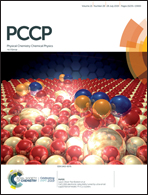Tuning molecular dynamics by hydration and confinement: antiplasticizing effect of water in hydrated prilocaine nanoclusters†
Abstract
In glass-forming substances, the addition of water tends to produce the effect of lowering the glass transition temperature, Tg. In a previous work by some of us (Ruiz et al., Sci. Rep., 2017, 7, 7470) we reported on a rare anti-plasticizing effect of water on the molecular dynamics of a simple molecular system, the pharmaceutically active prilocaine molecule, for which the addition of water leads to an increase of Tg. In the present work, we study pure and hydrated prilocaine confined in 0.5 nm and 1 nm pore size molecular sieves, and carry out a comparison with the bulk compounds in order to gain a better understanding of the microscopic mechanisms that result in this rare effect. We find that the Tg of the drug under nanometric confinement can be lower than the bulk value by as much as 17 K. Through the concurrent use of differential scanning calorimetry and broadband dielectric spectroscopy we are able to observe the antiplasticizing effect of water in prilocaine also under nanometric confinement, finding an increase of Tg of up to almost 6 K upon hydration. The extension of our analysis to nanoconfined systems provides a plausible explanation for the very uncommon antiplasticizing effect, based on the formation of water-prilocaine molecular complexes. Moreover, this study deepens the understanding of the behavior of drugs under confinement, which is of relevance not only from a fundamental point of view, but also for practical applications such as drug delivery.



 Please wait while we load your content...
Please wait while we load your content...